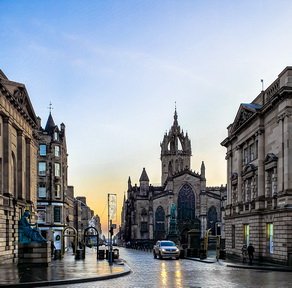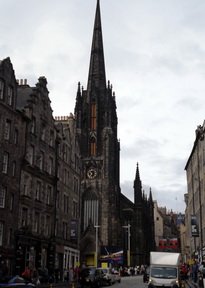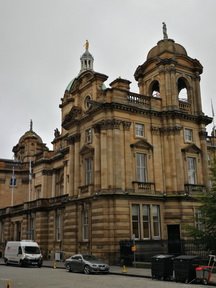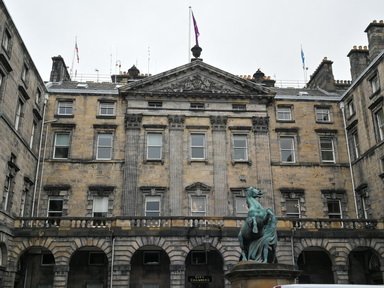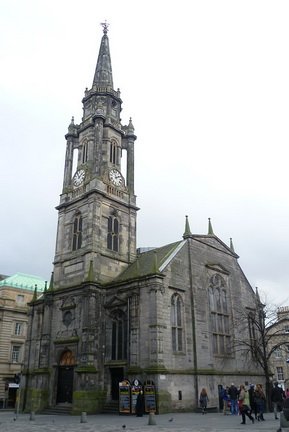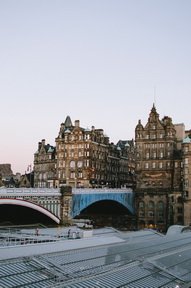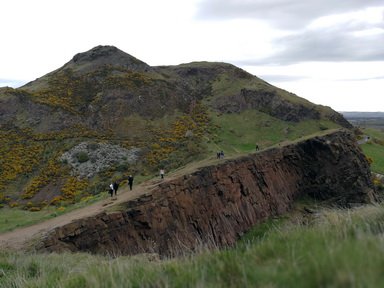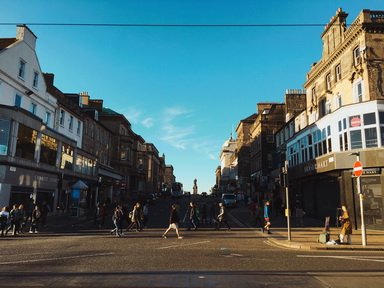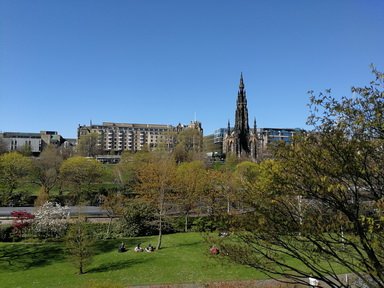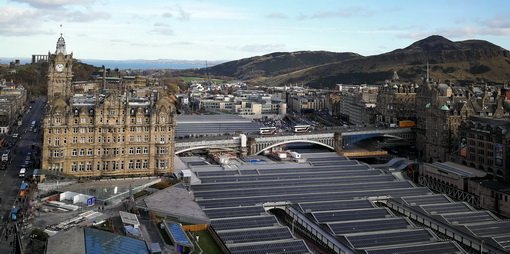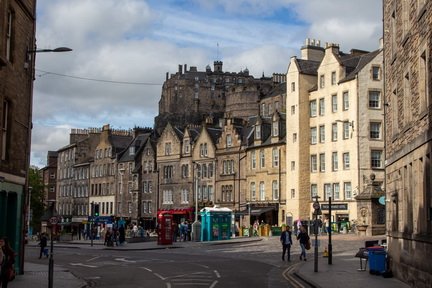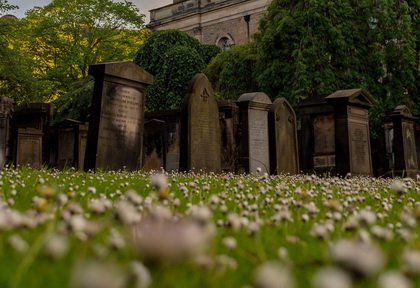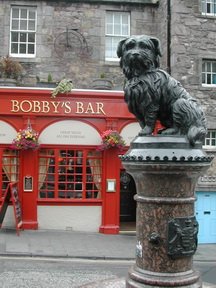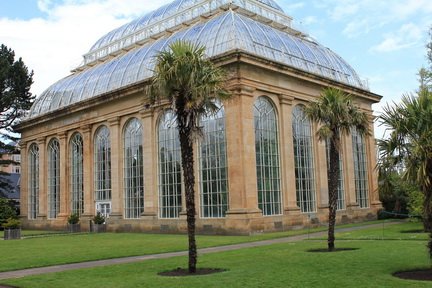Main attractions
Castle of Edinburgh – Holyrood Palace
1 Castle of Edinburgh – 2 Castle Esplanade – 3 Royal Mile – 4 The Hub – 5 Lawnamarket – 6 The Mound and its Museum – 7 St. Giles Cathedral – 8 Parliament Square – 9 Mercat Cross – 10 City Chambers – 11 Tron Kirk and South Bridge – 12 North Bridge – 13 John Knox House corner – 14 Netherbow Port and the World’s End – 15 Canongate Tolbooth and Kirkyard – 16 Scottish Parliament – 17 Holyrood Abbey and the Palace – 18 Holyrood Hills
Others
1 Castle of Edinburgh
Building standing today on the Castle Rock is a mighty reminder of the turbulent Scottish history. Behind those walls you will meet the first settlers that came here 3000 years BC and learn a few tricks about the warfare of old (and they do not come from the movie!). The museums there teach, the dungeons scare, the royal rooms stricken with the might of people long dead.
It inspired authors of the titles like Harry Potter or The game of thrones. It does it still – every look at those stones pushes our imagination to work. And the One O’Clock Gun reminds us about its long shadow, even when we cannot see it.
For the entrance you will need a ticket or Explorer Pass. There is a pretty good, but quite long audio-guide inside. You can also use this walk to show you around.
2 Castle Esplanade
The place in front of the castle is called that, but it exists in this form from XVIII century. Before it was just a path, then a road leading to the fortress.
It offers great views of the city. From the South you can see the districts: Grassmarket under your feet, Tollcross and Fountainbridge further away. In the distance there are Pentland Hills from where water came to the city from late medieval times. On the left – Holyrood Hills stick out of the middle of Edinburgh with its highest point called Arthur’s Seat. What catches your eye is a graveyard – the Greyfriars Cemetery; and a building with a clock – the George Heriott School.
View from the North offers a splendid panorama of the New Town, Leith and the waters of the Firth of Forth. The land in the distance is the Kingdom of Fife. In the gardens under your feet there is a black spire on your right – The Scott Monument. Two great ancient building close to the road, also in the gardens – are the quite modern art galleries.
Don’t warry if there is the scaffolding – you can see the views when you enter the castle. And the seats are needed and stand here from July to September. They are part of the Fringe Festival and the most prominent of all – the Military Tattoo takes place here.
3 Royal Mile
A mile and 1/8th of it to be exact. They say it is to confuse the Englishmen…
Either way the most famous street in Edinburgh links the Castle to the Holyrood Palace – two seats of the royal family. The hill with the top at the castle is the most prominent landmark in the town. It was created like that by the glaciers. They couldn’t move the basalt rock, so they went around it creating the characteristic slide on with lays the Royal Mile. To the North and to the South the streets lead down the hill – the smaller ones are called wynds and closes. Closes – because they once were closed by a gate. Wynds – because the wind could go up and down as it pleased.
Today the Royal Mile is divided into segments, going from the Castle down: Lawnmarket, High Street, Canongate.
4 The Hub
This building cannot be missed. It is first or the last – depending on going to or from the Castle. Moreover – it is easily seen from afar – especially its tower (itself 74 m high) which is the highest point in Edinburgh.
It looks like a gothic church but was created in XIX century according to the plans of J.Gillespie Graham and A.Pugin. It was supposed to be the home of the General Assembly of the Church of Scotland, but it never happened. It waited, its limestone walls turning darker with smoke and time. Finally, it became the home and the headquarter for the Fringe Festival and there is a nice restaurant inside.
5 Lawnamarket
The first part of the Royal Mile goes from the Hub to the next set of lights where George IV Bridge begins. Here you can find the remnants of the original market – but in the form of many shops. You can buy any souvenir from Scotland here starting with cashmere, whisky and finishing with gloves and a postcard.
Gladstone Land – a building with a golden eagle/owl is a prominent landmark – one of the oldest tenements in Edinburgh (coming from XVII century). It is a reasonably priced museum that shows you the live of the people of XVII century.
Among the closes of the North side there is the entrance to Wardrop’s Court – look for the names above the entrances or for two blue dragons. There you will find the Writer’s Museum. Entrance is free of charge and gives you two things. First – a visit in XVII city villa of Lady Stair. Second – a museum dedicated to the fames of Edinburgh – Sir Walter Scott, Robert Burns and Robert Louis Stevenson (more here).
Other prominent landmark of the Lawnmarket part is a figure of a gentleman with blue jacket standing next to Brodie’s Close (South side). It is a reminder of one Deacon William Brodie. His story can be read here.
6 The Mound and its Museum
The street of the same name is an artificial hill created while building the New Town in XVIII century. Today, as before, it is another way linking the old and the new towns.
On its top sits a neoclassical/baroque building with a dome. It is both the Headquarter of the Bank of Scotland and a museum of money. The last was opened in 1986 by the author Ian Rankin and, among many things, you can see a million pounds there!
7 St. Giles Cathedral
The church was created around XII century and served for the Christian worship at that time. With time it grew bigger, more gothic and became the High Kirk of the protestant religion sermoned by John Knox (Reformation).
It was a prison, a seat of the Scottish parliament. For a brief time in XVII century – a cathedral – thus the name of today.
It is a protestant kirk today and the interior shows it beautifully. It is so much different than Christian churches. You can find there a beautiful piece of art – the Thistle Chapel, tombs of prominent figures od city’s history or a stained glass in the memory of Robert Burns.
A sculpture of a stool shows us where the War of Three Kingdom begun. How it happened – check here.
8 Parliament Square
Situated behind the St Giles Cathedral this small square/parking can be easily missed. It was a graveyard for the church once, but in XVII century it was moved, and a Parliament House was put in here. Back then the square had only the statue of Charles II on the horse and the parliament on the West side. Later the Advocate wings were added – they house the law department nowadays.
Today it is a wonderful example of the Modern Athens of old! Edinburgh wanted to be like ancient civilizations and realized it through its architecture and the wisdom of its people. In XVIII and XIX many places received classical details and new, ancient-like buildings were constructed (like the art galleries). The main architects of that movement were: R.Reid, W.Playfair or Adams brothers.
The parking also houses a secret – the unmarked grave of the leader of Reformation – John Knox. Not “unmarked” today – just check the parking lot number 23.
9 Mercat Cross
The octagonal building towered by a column with a unicorn stands here since Gregorian times. It stands close to the original one – but today only its shape is marked by the cobbles further down the mile.
This too wasn’t original as they say but we can be fairly certain that there was a mercat cross already in XIV century. Why is it important – it marked a place of a medieval market and where the tradesmen were.
It also was a place of executions and public proclamations. You can still see the door leading up on the Mercat Cross reconstruction – they served to those purposes.
The medallions around it are the coat of Arms of important places in Edinburgh. The unicorn on top is also a symbol and the national animal of Scotland.
Close to the Mercat Cross stands a figure of a man in university robes. This is Adam Smith – the author of the Wealth of Nations and the father of economy.
10 City Chambers
The towering arcades give you the access to a square where you can fully take in the neoclassical façade of the City Chambers. They were built in XVIII century to house the merchants across the street, but they never wanted to go anywhere under a roof. Thus, it became a seat for the city council and today you can find city’s Provost inside.
The statue in the middle shows you young Alexander with his favorite horse Bucefalus. What’s more the building has two secrets:
- Part of it is closed because under it there is the Hidden City of Edinburgh – Mary King’s Close. This expensive but worthy attraction shows you the original streets and houses of XVII century. The entrance is next to the City Chambers
- Although from the front you can only see 3 storeys try going to a street behind – Cockburn Street. You will see at least 4 more floors going down. This is a reminder of how the Old Town was built – down the hill, and that it was once Manhattan of Old (tenements of up to 16 floors)
11 Tron Kirk and South Bridge
The church-like building at the traffic lights stands here since the XVII century. It was created for the protestant worshippers when St Giles was turned into a cathedral. Even after everything went back to normal the building stayed here.
Today you see it blackened and with a reconstructed tower (because of a fire). It was also shortened to make way for the building of modern roads – South Bridge and Blare Street. It houses sort of a souvenir shop and expositions sometimes.
The South Bridge is a road leading… surprise… South! You cannot see it as a bridge because of the rows of buildings on both sides. It was constructed in XVIII century as part of the modernization of the city and creation of the New Town. Thanks to it there was no need to go down to Cowgate and up to southern quarters. Its buildings were supposed to be a new place for merchants from the Royal Mile.
If you want to see the only arch of the bridge – go down Blair Street. You will also see there the entrance to another paying attraction – Underground Vaults. They were supposed to house the warehouses but instead became a place of living for the poor. People also say they are haunted…
12 North Bridge
First one of two bridges here – this one was also created at the end of XVIII century. It connected the Royal Mile with the newly built New Town in an easier way.
It is a wonderful piece of architecture with splendid views to the Calton Hill. If you manage you can also see down – to the valley where Waverley Train Station is situated.
13 John Knox House corner
This lovely white building is the oldest common house in Edinburgh. It comes from XV century and belonged to the Mossman family – not John Knox as its name says.
From the outside It is reconstructed to represent a typical house of that time, with the exterior staircase and ornaments. Inside it is possible to visit it and learn that the Mossman family worked on the royal court as goldsmiths.
At the same corner – Maubray House is another example of a tenement. The staircase leads to the first floor and you can see inscription on the right. It was once home to Daniel Defoe, who – inspired by Scottish history – wrote Robinson Crusoe. The very figure decorating the house is the original of the hero.
Another prominent landmark is a stone cube with two strange faces standing next to the road. Just imagine a wooden handle coming from the mouth and a bucket underneath and you will know the answer. This is an example of a well that distributed water in the city. It came from a reservoir next to the castle and then, by the force of gravity, it went further down.
14 Netherbow Port and the World’s End
The bluish façade of the nearby building shows you the localization of a Pub named World’s End. The name comes from the limits of Edinburgh of old.
This crossroads was once towered by a gate. A wall went down to the South and North circling the city – the Flodden Wall. The Netherbow Port was its Western entrance. It was demolished in XVIII century to make room for traffic. You can still see its cobbled shape on the ground.
It was also symbolic. Before there was Edinburgh and another burgh – Canongate. In modern times both cities became one and Canongate is now reminded in the name of the street.
15 Canongate Tolbooth and Kirkyard
It is impossible to miss this stone building, but if you are having troubles – look for the clock hanging above the road. Tolbooth was once a place where city council met, where was a prison or police station or execution point. In short – it housed all the administration of a medieval Scottish burgh/city.
With all those small towers it must have looked very representative when it was constructed in XVI century. Today it houses People’s Story Museum.
Another visible feature is the coat of arms of Canongate on its wall – a stag with a cross between the antlers. It comes from a legend that started the Holyrood Abbey.
On the opposite side of the road – another museum – Edinburgh City Museum. It is free to visit and shows various pictures and souvenirs of the town’s past (Bobby’s collar for example).
The church next to the Tolbooth is surrounded by a wall and stands in the middle of the cemetery. It was built in XVII century after the destruction of the abbey. The graveyard around it is a place telling its own stories – there is a tomb of Robert Fergusson in here, of Adam Smith and the view from the back is amazing.
16 Scottish Parliament
This modern building stands in contrast with its surrounding. It was done in purpose because the architect – Enric Miralles wanted it to be a symbolic representation of Scotland – with its hills, lakes and boats on the shore (best visible from the air view).
It stands here since 2004 and is a small victory of Scotland. After a referendum in 1996 it was decided that the parliament will return to Edinburgh after almost 300 years of absence. After the Union of Parliaments 1707 Scotland lost its last shred of independence. A former Kingdom of Alba, proud country of Scotland, became part of England. It was difficult to swallow – even with a Scottish king on the throne in London.
You can visit this place, for free every day. Just check the times on its website.
17 Holyrood Abbey and the Palace
The legend says that king David I once had an accident while hunting in the forests that were once nearby. A stag wanted to pierce him with its antlers. He prayed, promised and God saved his life. His word to the Almighty was that he would build an abbey and so he did. It was around XII century. From this time until the Reformation of XVI century Augustin monks took care of the lands.
They soon attracted people who started to settle nearby. An abbey turned into a village that was called – after the monks – Canongate. Soon a palace was built next to the church – because the king liked the calm surrounding of the place. Thus, the Palace was born and it was around XV century.
Today you can only see the ruins of the Church that once stood here. It was destroyed mostly during Reformation. The original Palace is the one that you first see when you enter the place. But many more wings and rooms and walls were added making it true house of the royalty.
It was forgotten when the king of Scotland became also the king of England in XVIII century. But it returned to the pages of history as a place for tourists and soon – the summer residence of royalty. The Queen comes here every year for a few weeks visit in Scotland – the palace is closed for tourists then.
You can visit the Palace with a ticket and an audio-guide telling its history. There is also Queen’s Gallery to see and beautiful gardens (open only in warm months).
18 Holyrood Hills
From the vantage point between the Palace and the Parliament a green mountain is easily seen. Its most visible landmark is a streak of brown rock running horizontal on its western side. These are the Salisbury Crags created by the movement of earth. Once a man looked at them and wrote a theory that the Earth is older that the Bible says… It was James Hutton – the father of geology.
The Crags are only a part of a complex called Holyrood Park. It is an extinct volcano, a hill today, and it towers over Edinburgh as its protector. There is plenty of pathways around it – perfect for a sunny day between tourist visits. Its highest peak has 251 m high and is called the Arthur’s Seat. A walk from the Holyrood Palace up there takes you about 1,5 hours.
19 New Town
The Georgian suburb of central Edinburgh was created in a few stages, starting with 1767. The intention was to let the overcrowded city grow, and a suitable place was in the North.
Architect James Craig designed an ingenious plan for those times. Spacious quarters for maximum 3 storeys high houses. Wide streets, running water, gas lighting – everything promised to the residents new and modern world.
The symbolism of the place gave an additional bonus – expressed the unification of two nations – Scotland and England. Ans so we have everything connected to the two worlds: national flowers and Saints, names of the royal family, monuments dedicated to them. Every detail speaks volumes.
Two squares with monuments are flanking the New Town of Edinburgh – Charlotte Square and Andrew Square. The most notable streets take its name after the king – George Street – it is full of statues of prominent people of the past and important buildings. The other one that is an attraction for tourists is the Rose Street – full of pubs and restaurants and with a specific charm.
20 Princes Street and Gardens
Princes Street is the main axis of Edinburgh today. It is also the road that leads tourists from the airport to the city – their first impression is the Old Town on the right and the New Town on the left.
It takes its name after the sons of king George III. At its beginnings it was a market street and obviously – it is still so.
Next to it there lies the gardens of the same name. They were a valley once – created by a glacier, with moors and an eerie river running through. It was made into North Lake around XV century but then drained in XVIII with the modern era. It is said witches were drowned here, among others.
Today they are a great green space in the middle of the town. They are full of statues commemorating famous people and historical events. Some sort of a monument is the Scott Monument and two art galleries that look like ancient temples. You can find those in the middle of the gardens, next to the road. The one closer to Princes Street has a wonderful statue of Queen Victoria on top. They are free to visit.
Close to the galleries, next to the stairs leading down to the gardens, you will also find a flower clock. It is constructed here every year with the beginning of summer.
21 Scott Monument
A great black spire goes 61 m high. 287 steps lead to the top where you can find a great view of the surrounding.
It was created for the most famous of Scots – Sir Walter Scott. He was an advocate, historian, protector of Scottish culture and a writer. Rob Roy is one of his creations. He also found the long-lost crown jewels of Scotland.
His death found him in 1832. Soon a competition was announced for a monument to the author. It was won by George Meikle Kemp and the works started in 1838.
Tower is in gothic style, decorated by the figures of Scott’s novels. The author, made of marble, sits in the center under the arch, among his countrymen.
22 Waverley Train Station
The hidden train station is unrecognizable from afar. Especially if you do not see the train tracks.
It stands here from the beginnings of industrial revolution in mid XIX century. It changed, received greater for and was named after Walter Scott’s novels – Tales of Waverley. These were stories that brought fame to Scotland and soon tourists travelling to this very spot. Station is also decorated with the quotes from the books.
It is connected to the mall which also gives the access to the insides of the building. I mention this on purpose – the roof is a great spot to take a photo of the Old Town and its tenements.
23 Calton Hill
The hill known also “The Hill of the Fairies” is full of monuments and a good and free point to see the city from above. I strongly recommend the view to Leith and to the Princes Street. The second one, especially in the evening, is full of live, lights and inner charm. You can scope the castle and the Balmoral Hotel – known by a tower with a clock.
Calton Hill is mostly used to scare children – not only by folk’s tales but also by nightly crimes – as people say… It is also a place where the fire procession of Beltane Festival takes place.
Before you get there the most visible from afar is the Nelson Monument. It looks like a tower with a cross on top. A ball is lifted everyday onto that cross – why? Read in the castle article.
The domes belong to the Old Planetarium and a small rotunda of Dougald Stewart Monument (notable University’s professor).
But it is when you enter the hill that you can see the National Monument of Scotland. Few Greek columns were the beginning of a Greek temple to match the one in Athens. It was to aspire to the proud nickname that Edinburgh had in XIX century – Athens of the North or Modern Athens. But it was never finished and another name for it is also “the shame of Edinburgh”.
24 Grassmarket
The road to Grassmarket often leads tourists through Victoria Street – a lovely colorful and magical place.
Grassmarket is a big square when you can find a good place to eat or drink. AS the name says it was once a market and one is still held here on weekends.
It also offers a nice view to the castle. Although people come here mostly to see the Covenanters’ Monument – a round, stone circle surrounded by small wall in the eastern part of the place. It is dedicated to people who lost their lives in the civil war of XVII century when Protestants fought the Catholics.
It also stands in the very spot where the gallows used to be. A shape in the pavement shows its shadow and the names of nearby pubs tell the story (Last Drop).
25 Greyfriars Kirkyard
It is not creepy to visit cemeteries in Edinburgh – it is mostly normal. This one is one of the oldest, created in the XVI century. They moved the burial ground here because the space near St Giles was too small. The church was built soon after and so it stands now in the middle.
People like to walk here for various reasons. They treat it as a park, or they are looking for the many ghost that it is supposed to have. They look for Harry Potter’s magic here or for graverobbers.
Definitely – they come here for the grave of its most famous occupant – a dog named Bobby.
26 Bobby Statue
A small’s dog sculpture stands next to the George IV Bridge between the National Museum of Scotland and the main entrance to Greyfriars Kirkyard. It is a 1:1 image of a Skye Terrier who was known by many people in this neighborhood until he died in 1870.
It commemorates the faithful dog that visited his owners grave for 12 years. When he died he couldn’t be buried close to his owner. That were the rules of saint ground. But he is closest as possible. As you enter the cemetery through the front gate – his tomb is the first one to see. It is strange as well, because it is situated in the pathway.
27 National Museum of Scotland
A great, imposing building stands on Chalmers Street, with the entrance close to George IV Bridge. Museum consists of the original building from the XIX century and its modern extension of sand color. It is free to visit and definitely worth it. Preferably on one of those rainy, Scottish days.
You can find there artifacts coming from Edinburgh and Scotland. Stories of the animals that lived here including Dolly the cloned sheep. There is a whole wing dedicated to Scottish inventions – like Bell’s telephone. Top floors give you the modern history of Scotland with its bridges, trains, cashmere weavers. In opposition – on the bottom you can find the maiden – exact replica of the one that once stood on the streets of this town.
28 Elephant House
This small restaurant with a red front sits on George IV Bridge between the Greyfriars and the Royal Mile.
It is a site visited by Harry Potter fans and it is always full. Many come to see the collection of things connected to J.K. Rowling and maybe sit on the very spot where she once sat. The back of the restaurants offers a lovely view to the cemetery and the castle. It was probably what inspired the creation of Hogwarts.
You can read more in Harry Potter Walk.
29 Royal Botanic Gardens
Situated on the exterior of New Town – the gardens are accessible by bus or a long walk.
In the exception of Orangery/Palm House – they are free to visit. You will find there a lot of citizens, walking around and enjoying the weekend’s sun.
They grew from a physic garden founded in 1670 and consist of over 13000 plant species. They are still a site of scientific study – as they were in the beginnings.


